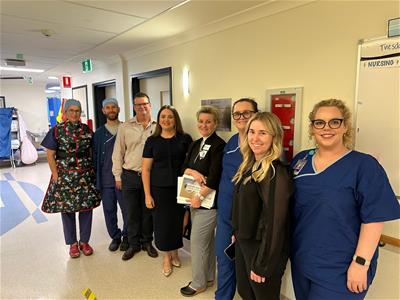 Earlier this year, St Andrew’s War Memorial Hospital achieved international accreditation by the American College of Cardiology, recognising our Cardiac Catheter Theatres and catheterisation program for excellence.
Earlier this year, St Andrew’s War Memorial Hospital achieved international accreditation by the American College of Cardiology, recognising our Cardiac Catheter Theatres and catheterisation program for excellence.
But we thought it may have left you wondering, what is a Cardiac Catheter Theatre and what happens there?
In recognition of Heart Week – Australia’s national heart health awareness week held annually in May – we stopped by to ask our Cardiac Catheter Theatre team to answer some of those questions.
1. What is a cardiac catheter theatre and what types of procedures are performed here?
A Cardiac Catheter Theatre (CCT), also known as a Cardiac Catherisation Lab or Cath Lab, is a specialised procedural unit where a multidisciplinary team of doctors, nurses, radiographers and scientists work together to diagnose and treat heart conditions using minimally invasive, catheter-based procedures.
Common procedures performed here are coronary angiography, percutaneous coronary intervention or angioplasty, right heart catheterisation, electrophysiology (EP) studies, ablation therapy, pacemaker and implantable cardioverter-defibrillator (ICD) insertion, congenital defect closures and advanced valve interventions such as Transcatheter Aortic Valve Implantation (TAVI) and Transcatheter mitral valve-in-valve (TMVIV).
2. Who might need a cardiac catheterisation, and how is a patient referred to CCT?
Patients may need a cardiac catheterisation if they have:
- Chest Pain or suspected angina
- Abnormal stress test results
- Shortness of breath or suspected heart failure
- Abnormal heart rhythms (arrhythmias)
- Congenital heart defects
- Suspected valve disease.
Referral to come and see us is usually through your GP and subsequent referral to one of our St Andrew’s cardiologists. Or if you are experiencing signs and symptoms of a serious heart attack or emergent cardiac condition, you can present and be seen via our Emergency Centre.
3. Tell us about a typical day in CCT. What’s involved and which healthcare professionals are part of the team?
Interventional, electrophysiology and general cardiologists work alongside cath lab nurses, anaesthetic nurses, structural heart coordinators, cardiac radiographers, cardiac physiologists, anaesthetists, administration and auxiliary and volunteer support services in order to deliver high quality and patient-focused cardiac care.
4. What advances in technology or techniques have made the biggest impact in recent years?
There are so many! Most recently at St Andrew’s, the cath lab has achieved a major milestone by becoming the first hospital in Australia to be accredited as a Cardiovascular Centre of Excellence (CCOE) for Percutaneous Coronary Intervention (PCI). This certification reflects our commitment to the highest standards in cardiac care, and underpins both the quality and consistency of our patient outcomes. It’s a proud moment for the team and a big win for our patients.
We’re also proud to be recognised as a JAPAC Centre of Excellence for TAVI, having performed around 1,500 procedures to date. With 2025 marking the 10-year anniversary of our TAVI service, it’s clear that innovation and excellence in cardiac care are at the heart of what we do.
5. How do you help patients prepare and feel at ease before or during a procedure?
As a team, we help patients feel prepared and at ease in a number of ways. Uniquely in our department, team members often have the privilege of delivering an end-to-end procedural service – admitting the patient, performing the procedure, and providing post-operative care and education. This continuity creates a seamless, reassuring experience with familiar faces at every stage. We take time to explain each step, answer questions and build trust. And of course, a friendly smile and access to a never-ending stash of warm blankets goes a long way too!
Find out more about cardiac care at St Andrew’s War Memorial Hospital.